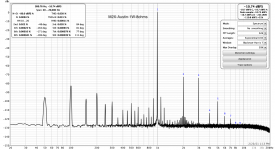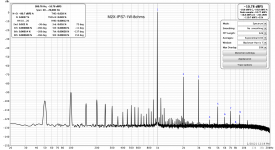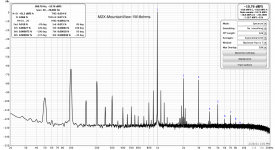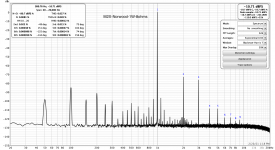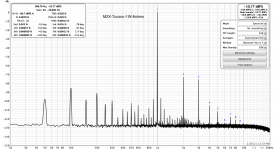It’s been several weeks now, but I had no issues ordering off the BOM. But that stuff can go fast. Do they say when more are due? (1,700 due 4/19, and more this summer)
Newark and Arrow have the transistors.
Mouser is also out of 120 ohm resistors as well for a few days (02/22).
Mouser is also out of 120 ohm resistors as well for a few days (02/22).
I naively ordered the 44G and the 45 non G. Physically they measure the same. ???
I don't even know what I have done to the flow of electrons on Mark's board. Sounds Great. Report at lunch time.
Houston, do I have a problem?
Don
I don't even know what I have done to the flow of electrons on Mark's board. Sounds Great. Report at lunch time.
Houston, do I have a problem?
Don
Newark and Arrow have the transistors.
Mouser is also out of 120 ohm resistors as well for a few days (02/22).
Arrow has the MV5075C but it's $65 for shipping for us poor saps in the Great White North! 😡
Regards,
Dan
You have failed to read M2x post #3318. Please correct this error.
Mark,
Many thanks for your patience and help.
Regards,
Dan
Cedarburg G v nonG transistors
Everybody in the world probably already knows this but "G" is the lead free version.
Don
Everybody in the world probably already knows this but "G" is the lead free version.
Don
You have failed to read M2x post #3318. Please correct this error.
You're funny...😀😀😀
Everybody in the world probably already knows this but "G" is the lead free version.
Don
I didn´t know...
Cedarburg report
Noticeably different and in my opinion much better. I was running Ishikawa.
Cedarburg is noticeably better in two important characteristics.Crispness/clarity and also Timbre. It also comes through a little louder on my system which is a plus.
There may be slightly more detail which helps drive the big changes but it is hard for me to say because of the way clarity and timbre manifest themselves. Ishikawa actually sounds a little muffled compared to Cedarburg.
Some may characterize Cedarburg as not as smooth and a little more fatiguing but I like to hear everything there is to hear and Cedarburg is a big plus with that. And, the better the recording the better it comes through.
I don't have a downside to report. I listened to Classical, Vocal, Pop, and Rock. All better. I only have original pressing records (not necessarily first pressings) not remastered.. I am finding there is a big difference in the quality of the recordings.. something I have to figure out.
Thank you Mark. For your designs and for helping me to grow. (not a proper sentence)
Don
PS, it's going to take an awfully good report to make me want to take this board out😀
Noticeably different and in my opinion much better. I was running Ishikawa.
Cedarburg is noticeably better in two important characteristics.Crispness/clarity and also Timbre. It also comes through a little louder on my system which is a plus.
There may be slightly more detail which helps drive the big changes but it is hard for me to say because of the way clarity and timbre manifest themselves. Ishikawa actually sounds a little muffled compared to Cedarburg.
Some may characterize Cedarburg as not as smooth and a little more fatiguing but I like to hear everything there is to hear and Cedarburg is a big plus with that. And, the better the recording the better it comes through.
I don't have a downside to report. I listened to Classical, Vocal, Pop, and Rock. All better. I only have original pressing records (not necessarily first pressings) not remastered.. I am finding there is a big difference in the quality of the recordings.. something I have to figure out.
Thank you Mark. For your designs and for helping me to grow. (not a proper sentence)
Don
PS, it's going to take an awfully good report to make me want to take this board out😀
Noticeably different and in my opinion much better. I was running Ishikawa.
Cedarburg is noticeably better in two important characteristics.Crispness/clarity and also Timbre. It also comes through a little louder on my system which is a plus.
There may be slightly more detail which helps drive the big changes but it is hard for me to say because of the way clarity and timbre manifest themselves. Ishikawa actually sounds a little muffled compared to Cedarburg.
Some may characterize Cedarburg as not as smooth and a little more fatiguing but I like to hear everything there is to hear and Cedarburg is a big plus with that. And, the better the recording the better it comes through.
I don't have a downside to report. I listened to Classical, Vocal, Pop, and Rock. All better. I only have original pressing records (not necessarily first pressings) not remastered.. I am finding there is a big difference in the quality of the recordings.. something I have to figure out.
Thank you Mark. For your designs and for helping me to grow. (not a proper sentence)
Don
PS, it's going to take an awfully good report to make me want to take this board out😀
That's a great report and very motivating! I wish these reports came up more often. I also like to hear clarity everything. I can correct any perceived harshness 'in post' with the MiniDSP SHD studio.
I would make the IPS7 with LME49720 and see how you like that.
You're funny...😀😀😀
There is a degree of humor in that type of diplomacy! 😉
Regards,
Dan
The IPS daughter card which sounds best is: whichever one you built most recently! Proud parent bias is unavoidable and powerful.
Train your roommate or life partner so they are experts at swapping out M2x IPS daughter cards, then ask them to help you perform a blind A versus B listening test. Have the daughter card swapping person take photos with timestamps ,or create other incorruptible proofs of which was A and which was B, so there's no possibility of argument. Then listen and truly find out: which card do you prefer in a blind listening session.
Train your roommate or life partner so they are experts at swapping out M2x IPS daughter cards, then ask them to help you perform a blind A versus B listening test. Have the daughter card swapping person take photos with timestamps ,or create other incorruptible proofs of which was A and which was B, so there's no possibility of argument. Then listen and truly find out: which card do you prefer in a blind listening session.
By that rationale it would also apply to the last opamp you swap in the card. And that has not been the case.
Now that I know the bias exists I can fancy myself a little more nuanced than that. LOL
Now that I know the bias exists I can fancy myself a little more nuanced than that. LOL
Last edited:
Has anybody "passed" an A/B blind test that with high probability (> 80%) could hear a difference between two input boards?
Concerning the differences of the buffer cards. I have made distortion measurements using Focusrite 2i2 with REW of my M2X with all the daugher cards I have (I do not have ..hm.. Ishikawa, IPS6 and Cedarburg).
Buffer being a buffer, I do not see any differences in the most important H2 and H3 between the daugher cards. Higher harmonics do differ a bit, but, being low, I am not sure if this could be just small variations in measuments, or if we could hear these small differences anyway.
What I found the cards differ in is how much they are prone to the hum and buzz from the power supply (at least in my M2X - I have transformer under a steel cover and Edcors covered by the mu-metal boxes without a lid from the heatsinks side).
My ears and my measurements tells me that Mountain View picks up the hum most easily. All other copes with that much better, with Norwood and IPS7 being my favourites in this aspect.
We all have our favorite cards. How much it is based on the sound and how much on other aspects like ideas of design, components used etc. - everyone can decide for himself.
I attach the pictures of my measurements if anybody is interested. I do not pretend these measurements are precise, but they are made with the same conditions, on the same channel of the amplifier, so I hope they are comparable between themselves.
Best regards
-Alvis
Buffer being a buffer, I do not see any differences in the most important H2 and H3 between the daugher cards. Higher harmonics do differ a bit, but, being low, I am not sure if this could be just small variations in measuments, or if we could hear these small differences anyway.
What I found the cards differ in is how much they are prone to the hum and buzz from the power supply (at least in my M2X - I have transformer under a steel cover and Edcors covered by the mu-metal boxes without a lid from the heatsinks side).
My ears and my measurements tells me that Mountain View picks up the hum most easily. All other copes with that much better, with Norwood and IPS7 being my favourites in this aspect.
We all have our favorite cards. How much it is based on the sound and how much on other aspects like ideas of design, components used etc. - everyone can decide for himself.
I attach the pictures of my measurements if anybody is interested. I do not pretend these measurements are precise, but they are made with the same conditions, on the same channel of the amplifier, so I hope they are comparable between themselves.
Best regards
-Alvis
Attachments
Noticeably different and in my opinion much better. I was running Ishikawa.
Cedarburg is noticeably better in two important characteristics.Crispness/clarity and also Timbre. It also comes through a little louder on my system which is a plus.
There may be slightly more detail which helps drive the big changes but it is hard for me to say because of the way clarity and timbre manifest themselves. Ishikawa actually sounds a little muffled compared to Cedarburg.
Some may characterize Cedarburg as not as smooth and a little more fatiguing but I like to hear everything there is to hear and Cedarburg is a big plus with that. And, the better the recording the better it comes through.
I don't have a downside to report. I listened to Classical, Vocal, Pop, and Rock. All better. I only have original pressing records (not necessarily first pressings) not remastered.. I am finding there is a big difference in the quality of the recordings.. something I have to figure out.
Thank you Mark. For your designs and for helping me to grow. (not a proper sentence)
Don
PS, it's going to take an awfully good report to make me want to take this board out😀
Don, is this with Salas's UFSP? What cart? I will be trying out the Cedarburg's ASAP. Not to derail this—you can PM me too—I have found that the cart and phono pre are HUGE factors in all of this—in my system anyway—in that order. (part of why my plan is to build a deck w two arms) Ie: I can "improve" to my ears daughter card X with a cart change (and vice versa) they all seem to have root personalities though—so exciting, and that just adds to all the mystery and general awesomeness options. Plus any cap change in the C3 position of UFSP has major influences, as does loading and treble trim. Even with all of the above—one can still pick apart the same album pressed by different places from different sources...Love or not love—Michael Fremer has hours of youtube vids regarding pressings and history and opinions. Fascinating stuff.
For Calculus-II types of people who wish to analyze the Cedarburg circuit, I'd recommend Chapter XIII in James Roberge's textbook, which MIT has uploaded as .pdf under ...
Advanced circuit analysts may also enjoy calculating Cedarburg's output impedance.
I only claim to be able to pick up differences frequency response, imaging depth and in noise. Definitely not differences in harmonics distribution on a 1KHz fundamental.
I think we should expect audiophiles to at least be able to pickup differences when turning tone control knobs or modifying the room correction parameters...the basics.
When playing music some opamps sound clearly rolled off for whatever reason.
I do like THD measurement quite alot and I instinctively gravitate towards low distortion at least initially. AVI what opamp did you have in the IPS7? Rolling opamps and measuring distortion maybe a very valuable endeavor here.
Having said that, if you are listening through a Tannoy concentric driver, the OPA series maybe for you.
I think we should expect audiophiles to at least be able to pickup differences when turning tone control knobs or modifying the room correction parameters...the basics.
When playing music some opamps sound clearly rolled off for whatever reason.
I do like THD measurement quite alot and I instinctively gravitate towards low distortion at least initially. AVI what opamp did you have in the IPS7? Rolling opamps and measuring distortion maybe a very valuable endeavor here.
Having said that, if you are listening through a Tannoy concentric driver, the OPA series maybe for you.
- Home
- Amplifiers
- Pass Labs
- The diyAudio First Watt M2x
